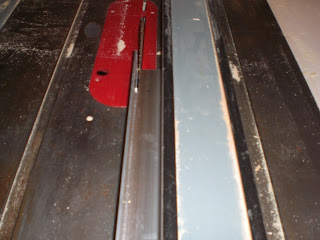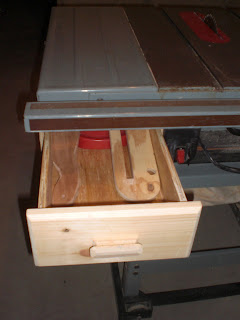My psychotic organizational side is very pleased with this project. Simple and short, it nonetheless managed to make my life a whole lot easier and my shop a whole lot more organized. I got to try out a couple of new things, as well, and in the end I'm pretty happy with how it turned out!
I got the idea from an issue of ShopNotes magazine (#70), a companion publication to my usual favorite Woodsmith. They had a two-page article on adding a simple drawer underneath one wing of a table saw. I knew as soon as I saw it that this would save me tons of trouble - push sticks, extra blades, wrench, my new stacked dado set, and a whole bunch of other things that normally clutter up the
The project had only three parts: the case, the drawer, and the mounting brackets.
Case
It's pretty simple - a top, bottom, two sides, and a back. I used three sheets of half inch 2'x2' plywood that my wife spotted in the Home Depot clearance bin for $1.00 each. I cut the case sides 5" wide (leaving the length at 23 7/8"), and the case bottom and top 10 1/2" wide. The bottom and top measurements depend on how much space you have between the edge of the table saw and the on/off switch - my measurements are based on a Delta contractor's saw.
Once it was cut to size, I set up my new stacked dado set to cut tongue and dado joints (Google just found me a video demonstrating the process here). I cut a tongue on both sides of the top/bottom pieces, and matching grooves on the top and bottom of the side pieces.
Glue and clamps put the case together, and I put in a few nails with my brad gun for good measure.
Once the glue has dried, cut a board to just fit in the back and glue/nail it in place.
Drawer
This part was almost as simple: two sides, two ends, and a bottom piece.
Sides: 23 5/16" long, 4" wide
Ends: 9 5/16" long, 4" wide
Bottom: 22 1/2" long, 9 1/2" wide.
Tongue and dado again, cutting dadoes on the bottom of the end pieces and the bottom and sides of the side pieces, and cutting tongues on the sides of the end pieces and all around the bottom piece.
Assemble the drawer (do a dry fitting with no glue first, and test the result to see if it slides easily into the case). Once you're happy, go ahead and glue/clamp/nail it.
The drawer is almost done now: my next step was to add a false front to the drawer, a nice-looking face piece that will be the visible part of the drawer.
I had a spare scrap of 1x6 that I cut to match the open width of the case (NOT the drawer). It should be roughly 1/2" larger on every side than the drawer. I think it ended up being 5"x11" on mine.
Cut it to size, then use the table saw set at a 45 degree angle to cut a chamfer all the way around the facing side of the drawer.
Clamp it in position sticking out 1/2" beyond each edge of the drawer (note the spacers on the side to make sure the distance is right - I put the drawer on top of scrap 1/2" plywood to make sure it was correct), and screw it in place from the inside.
That finishes the drawer, except for one small detail: the handle. You can use any cabinet or drawer handle for this, but I chose to try making one out of a scrap 2x3 piece just because I could. I got the idea from another Woodsmith issue (#205), but forgot to take pictures. Essentially, you set the table saw blade at different heights to create a scooped hollow in the middle of the blank, then smooth down the cuts (I wrapped a piece of sandpaper around the handle of an old foam paintbrush). I can do a blog post on that if anyone's interested in seeing the details.
Mounting Brackets
Two of the brackets (on the outside edge) are straight, while the other two (on the inside edge) have a short lip on one side. I wound up using a piece of aluminum angle (2"x2"), and cutting it to size with my table saw using a junky old blade I don't care about and being careful to clean up afterwards.
According to what I've read, the key to cutting aluminum with regular tools is to go slowly, use plenty of eye and ear protection, use a blade you don't care too much about (and clean it afterward) and avoid any chance of kickback. With that in mind, I set up my table saw carefully.
My first cut was made just to the inside of the angle, 4" deep into the aluminum angle. This gave me the start of the two straight pieces.
Next, I used the fence to mark the 2" line and clamped the aluminum to my miter gauge.
Cut off the two straight pieces, then reposition the aluminum to cut off the two angled pieces. If you want a smaller lip on these, make sure to slice the aluminum before separating the small pieces from the larger stock. It's safer to make cuts on a long piece than a short piece.
Use a file to smooth away any burrs or sharp edges.
Once that's done, drill a hole in the top of each piece large enough to fit the bolts holding your table saw's extension wing. Then drill smaller holes in the bottom of the two straight pieces large enough to fit a single wood screw.
Mount the aluminum pieces on the table saw (straight on the edge, angled on the inside with the angle pointing out towards the other pieces. Measure the distance between them and cut out two pieces of wood to fit inside, with a kerf on one side wide enough to sit on top of the "ledge" formed by the inside angled pieces. Sorry, I didn't take any pictures of the brackets themselves!
Screw them to the top of the case, leaving enough space on the outside that the aluminum bracket will be flush with the edge of the case. Once these are mounted, you will be able to set the block on top of the inside (angled) mounting bracket, then screw through the outside (straight) mounting bracket into the side of the mounting block.
The drawer is now ready to mount! But I decided to make one modification to the design, to see if I could make my life one little bit easier. My miter gauge is always hanging around on top of the table, and I wanted to set up a way to store it.
Miter Gauge Holder
I cut a long, shallow angle into the sides of two scrap pieces by screwing them onto a piece of plywood and running it along the table saw (you can just barely see the pencil marks on the plywood).
Those got mounted on the underside of the case, just far enough apart to fit the bar of the miter gauge.
NOTE: if your miter gauge has a protrusion on the bottom (to lock it into the miter slot), you'll need to kerf the bottom of the two side pieces so it fits.
Then cut a piece of plywood to fit as a cover over the scraps - this will end up being the bottom of the miter gauge holder.
Done! Now I can just slide the miter gauge into the holder, and the angles will guide it into place.
Finish
My drawer is ready! Slide the mounting blocks over the angled brackets, use a clamp to hold it and bring it level, then screw the side brackets into the mounting blocks and it is ready for use.
I seriously love this project! It's already coming in so useful, keeping all sorts of little tools near my table saw but out of my way.
Materials:
Two and a half sheets of 2'x2' 1/2" plywood.
Eight inches of 2"x2" aluminum angle
Twelve 1 1/4" wood screws
One foot of 1x6 pine
Two feet of scrap 2x4
One pull knob
Cost:
Plywood - 2 1/2 sheets of 2x2 @ $1.00 each - $2.50
Aluminum - 8 inches @ $20.00 per four feet - $3.34
Pine - 12 inches @ $20.00 per ten feet ~$2.00
Adding in scrap, the entire project was less than $10.00 in materials used. If I'd bought everything at the minimum sold length, it would come in at more like $35.00 - but since that will be used in other projects, I don't worry about it.
















































